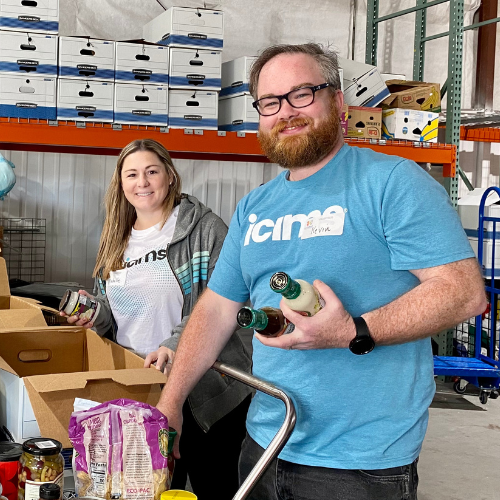- Solutions
- Products
- Community
- Resources
- Company
Create incredible candidate experiences that communicate your brand, mission, and values with recruitment marketing solutions.
Learn moreCommunicate effectively and efficiently with the candidates that can drive your business forward.
Learn moreSelect the right candidates to drive your business forward and simplify how you build winning, diverse teams.
Learn moreHelp your best internal talent connect to better opportunities and see new potential across your entire organization.
Learn moreCommunicate collectively with large groups of candidates and effectively tackle surges in hiring capacity.
Learn moreAccess tools that help your team create a more inclusive culture and propel your DEI program forward.
Learn moreRebound and respond to the new normal of retail with hiring systems that are agile enough to help you forge ahead.
Learn moreAccelerate the hiring of key talent to deliver point of care and support services that meet and exceed your promise of patient satisfaction.
Learn moreAttract and engage candidates with technical competencies, accelerate hiring for much-needed skills, and advance expertise within your valued workforce.
Learn moreSimplify how you recruit finance, insurance, and banking candidates with a unified platform built to match top talent with hard-to-fill roles.
Learn moreYour business strategy depends on your people strategy. Keep both in lockstep with the iCIMS Talent Cloud.
Learn moreBuild an engaging, high-converting talent pipeline that moves your business forward.
Learn moreDeliver the innovation your talent team needs, along with the global scale and security you demand.
Learn moreDeliver tailored technology experiences that delight users and power your talent transformation with the iCIMS Talent Cloud.
Learn moreThe #1 ATS in market share, our cloud-based recruiting software is built for both commercial and large, global employers.
Learn more Talk to salesAttract the best talent for your business with powerful, on-brand career websites that excite candidates and drive engagement.
Learn more Talk to salesCombine behavior-based marketing automation with AI insights to build talent pipelines, engage candidates with multi-channel marketing campaigns, and automatically surface the right talent for the job.
Learn more Talk to salesEmpower candidates with automated self-service, qualification screening, and interview scheduling through an AI-enabled digital assistant.
Learn more Talk to salesSimplify employee onboarding with automated processes that maximize engagement and accelerate productivity.
Learn more Talk to salesVerify skills with game-changing levels of automation and simplicity to improve the quality of hire at scale.
Learn more Talk to salesModernize, streamline, and accelerate your communication with candidates and employees.
Learn more Talk to salesTransform the talent experience by showcasing your authentic employer brand through employee-generated video testimonials.
Learn more Talk to salesSimplify recruiting, dynamically engage talent, and reduce hiring bias with job matching and recruiting chatbot technology.
Learn moreStreamline and centralize your HR tech stack with configurable, flexible, secure and reliable integrations.
Learn moreHow a beloved restaurant hires 40,000+ annually with a great candidate experience.
Learn moreThousands strong, our global community of talent professionals includes creatives, innovators, visionaries, and experts.
Learn moreTogether we’re creating the world’s largest ecosystem of integrated recruiting technologies.
Learn morePartner with our global professional services team to develop a winning strategy, build your team and manage change.
Learn moreExplore our network of more than 300 certified, trusted third-party service and advisory partners.
Learn moreUncover unique market insights, explore best practices and gain access to talent experts across out library of content.
Get resourcesExpert guidance about recruitment solutions, changes in the industry, and the future of talent.
Learn moreStay up to date with the latest terminology and verbiage in the HR software ecosystem.
Learn moreEmployers everywhere improve hiring efficiently and save money using iCIMS. Estimate the potential business value you can achieve.
Learn moreDive into the Class of 2023 Report highlighting this cohort’s expectations and where employers are willing — and able — to meet them.
Watch nowPartner with iCIMS to build the right strategies, processes, and experience to build a winning workforce.
Learn moreExpert guidance about recruitment solutions, changes in the industry, and the future of talent.
Learn moreDeliver the innovation your talent team needs, along with the global scale and security you demand.
Learn moreView press releases, media coverage, and the latest hiring data. See what analysts are saying about iCIMS.
Learn moreiCIMS is the Talent Cloud company that empowers organizations to attract, engage, hire, and advance the talent that builds a winning workforce.
Learn moreGet to know the award-winning leadership team shaping the future of the recruiting software industry.
Learn moreWe believe the future of work isn't something that "happens" to you. It's something you create. We actively create the future of work with our customers every day.
Learn moreiCIMS is committed to being a responsible and ethical corporate citizen, which is why Environmental, Social and Governance (ESG) initiatives are strategic imperatives.
Learn moreStreamline your tech stack and take advantage of a better user experience and stronger data governance with ADP and the iCIMS Talent Cloud.
Learn moreThe combined power of iCIMS and Infor helps organizations strategically align their business and talent objectives.
Learn moreOur award-winning partnership with Microsoft is grounded in a shared desire to transform the workplace and the hiring team experience.
Learn moreOur partnership with Ultimate Kronos Group (UKG) supports the entire talent lifecycle by bringing frictionless recruiting solutions to UKG Pro Onboarding.
Learn moreLet’s get in touch. Reach out to learn more about iCIMS products and services.
Learn more

At this point in the summer, employers in the food-service industry can find themselves in a tough spot. Roles in restaurants, bars, and quick-service and event establishments all require a high level of customer service and teamwork. But after a few busy summer weeks, workers in these positions might start feeling a bit of burn out or simply realize that they’re not the right fit. The resulting turnover can be extremely disruptive.
Unfortunately, this is a common issue faced by employers who seek hourly employees. The Bureau of Labor Statistics (BLS) estimates that there are roughly 77.2 million workers age 16 and older paid hourly rates, representing 58.7 percent of all wage and salary workers. Historically, turnover for this labor segment is high, 70 to 120 percent per year in most industries. That means that far too many employers are left in difficult positions, having to consistently navigate unstable staffing requirements and attempt to find new hires that will stay longer and perform better.
Successfully hiring food-service workers involves some creativity. Like the service they’ll ultimately provide, these job seekers want their candidate experience to be fast, easy, engaging and personal. Recruiters for whom reducing employee turnover is a top concern can follow these guidelines to help find and attract top talent.
How to Reduce Employee Turnover Before They’re Hired
To find employees who are in it for the long haul, you must start with an employer brand that attracts the candidates you want. First, be sure to develop a company career site that constructs a comprehensive employer story. Use photos, videos and engaging copy to highlight employee successes, brand values and the company culture. Go beyond the basic requirements of the roles and infuse your job postings with language that fits your business’ personality and gives job seekers a real glimpse into their day to day activities so they know what to expect.
Once you have a strong career site, extend your reach with search engine optimization (SEO) to improve online search listings on sites including Google, Yahoo, and Bing. SEO is becoming increasingly important, especially considering the recent launch of Google for Jobs, which provides access to Google’s machine learning capabilities to power smarter job search and recommendations within career sites, jobs boards, and other job matching sites and apps.
Recruiters would also be smart to prioritize a social media recruiting strategy as another layer of promotion targeting users on popular sites including Facebook, Twitter, and LinkedIn. If a candidate can follow your organization on these sites and see photos of the office, spotlights on current employees, and other company milestones and celebrations, they’ll feel more connected to your brand and have more of a vested interest in your success.
Recruit for Hospitality by Showing Hospitality
More than 80 percent of hourly workers are employed within a five-mile radius of their homes, and working close to home is a highly important factor among hourly job seekers. To increase your hourly hiring success and find best-fit candidates, use this knowledge to begin targeting candidates living locally to your business and cater to their lifestyles.
It’s most impactful to meet potential hires face-to-face so you can get a sense of their personalities. Participate in local job fairs in your community and host “open house” events where local candidates can learn more about your business and employment opportunities and better understand your brand. Event advertising, pre-registration and mobile resume uploads at the job fair are all much easier when using a candidate relationship management (CRM) tool. If you haven’t implemented a CRM as part of your recruiting tool kit already, you’re missing out on all of this crucial event support, reporting, and much more.
CRM software is critical for developing a strong talent pipeline, particularly for any business that hires hourly employees on a recurring basis. It allows you to develop talent pools full of passive candidates – whose contact information is collected at recruiting events or from a branded social connect page – to source from when the time is right. Better yet, you can organize talent pools based on certain roles (cashiers, servers, cooks, etc.) or by demonstrated soft skills like teamwork and communication.
Leverage recruitment marketing automation tools to not only organize passive candidates but nurture them. By providing regular email or text updates on company news and information, you will also cultivate more engaged new hires who are already familiar with your company since they have gotten to know you over time. And with candidate engagement software, you can see which candidates are most actively engaged with your content and reach out to them first when a job opens.
Get New Hires Ready to Go
Once you’ve found the right hire, there is still plenty you can do to ensure their long-term success. According to SHRM’s onboarding study, nearly half of all hourly workers leave new jobs within the first four months. As SHRM points out, employees who are onboarded using the “sink-or-swim” technique struggle to figure out what is expected and how they can be successful in their new work place. This can be a huge factor for turnover in the food-service industry which typically has a faster turnaround between the interview and the start date than other organizations.
Automated onboarding programs increase return-on-investment by helping to reduce preliminary recruiting costs and improving employee retention and productivity in the long run. An automated onboarding program eliminates reliance on paper documents and more importantly, avoids overloading new-hires with too much heavy information, the majority of which they will not use for several months or maybe never.
Instead, employees who benefit from a well-executed employee onboarding system have easy access to forms, employment information, and a view into the company’s culture prior to the first day of work. With videos, infographics, and even biographical introductions to key people with whom the employee will work, new employees gain a richer understanding of your company’s inner workings. So, on their first day, they can focus on providing exceptional service and developing team relationships, instead of worrying about overwhelming paperwork or feeling lost in the shuffle.




